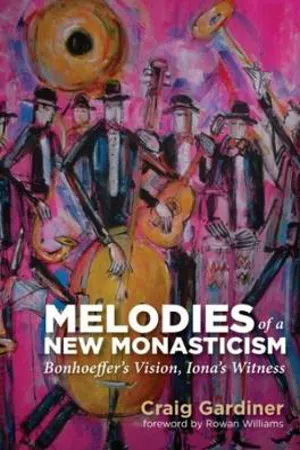![]()
Chapter 1
Introduction
The Melodies of George MacLeod and Dietrich Bonhoeffer
Have I spoken something, have I uttered something worthy of God? No . . . if I did say something, it is not what I wanted to say.
—Augustine
For we are not trying to build community. We can never do that. God sets us in community and it is man’s sin that he is always breaking it.
—Ralph Morton
From harmony, from heavenly harmony,This universal frame began;From harmony to harmony Through all the compass of the notes it ran,The diapason closing full in man.
—John Dryden
This book explores the nature of Christian community by drawing upon the fertile synergy of theology and music. It does not seek to offer a theological appraisal of music, but rather, through the metaphor of music, presents a theology of how Christians might seek to live together. It has no intention to theologize about music, but wants to engage in a theology of community through the metaphors of music. So it is sympathetic to Aristotle’s dictum that “midway between the unintelligible and the common place, it is metaphor which most produces knowledge.” It is hoped that using music in this way might “liberate our theology from some of its worst bad habits, and refresh it for the future.”
Arthur Koestler would call such an interaction between theology and music “a bisociative” methodology. He argues that bringing together previously unrelated subjects (bi-sociation) often precipitates a “eureka act,” which shows a familiar situation or event in a new light. At its core this insight is the basis of “all creative activities, artistic originality, scientific study, even the good joke.”
In addition to the central imagery of music, this book will employ a number of other metaphorical images through which the nature of Christian community will be explored. It is hoped that the richness of metaphorical reflection, particularly when the metaphors are mixed, will provide new horizons of thought and experience.
As well as mixing various metaphors, the book will develop the idea of bisociation by bringing together the life and work of Dietrich Bonhoeffer and George MacLeod, two twentieth-century Christians who never met and yet shared a passion for Christian community. While separate attention has been given to both of these individuals in other places, no one has yet brought together their thinking on community. So the book is not an attempt to offer a comprehensive examination of Christian community nor indeed does it offer a complete comparative biography of Bonhoeffer and MacLeod, but it does hope to offer a fresh perspective on what it means to be a Christian living with others in today’s world.
Music, Theology, and the Church
The bisociative relationship by which music is used to illuminate theology has been largely untested until recently and it remains so in examining the nature of Christian community. This is because theologians have historically been more concerned with the moral nature of music and its effects on society than they have been in its potential as an explorative metaphor. This is unusual given how throughout history communities have made music in a myriad of ways to reflect and express their experiences of celebration, anger, or lament. Music had a place in almost every activity and at almost every event in ancient Jewish life and was included in the Temple and Synagogue. Early Christianity evolved out of Judaism and while direct musical connections are ambiguous, music quickly became an inherent part of worship in churches such as those at Colossae and Ephesus, where Paul exhorted the people to “sing psalms, hymns and spiritual songs.” While music played an active role in the early church, no one considered how it might be a resource through which a theology of Christian community might be articulated. Indeed as the church evolved, music was viewed with some suspicion: attention habitually gravitated toward the ethical propriety of a particular instrument or performance. This suspicion may be because Genesis records Jubal, the ancestor of all who play the lyre and pipe, as being a descendant of the murderously sinful Cain. However, it is more realistic to think that Christian hostility to music, especially instrumental music, came from its association with the debauched entertainments of Graeco-Roman Society (Jewish theology had often displayed open antagonism to music for this very reason). But the embryonic church may not have followed the example of its Jewish cousin as readily as is often supposed. The first hint of a polemic against music did not appear until late in the second century. Thereafter, the criticism grew in intensity throughout the third century, as evidenced in the writings of Tertullian (160–225) and Arnobius (d. 330), and it became commonplace in the fourth-century theology of John Chrysostom (345–407), Ambrose (340–397), and Augustine (354–430). Chrysostom interpreted music as “sensual and pagan, obstructing our progress toward the real world of the spirit,” and Augustine expressed deep concern about being taken up into the emotion of music. But earlier church writers had been more sympathetic and even hinted at the possibility of doing theology through the metaphor of music. Ignatius (35–107) wrote in a letter to the Ephesians:
